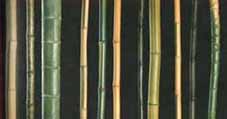
kinds of bamboo
guadua angustifolia
bamboo root
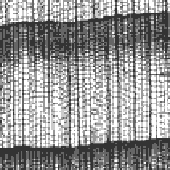
coniferous wood fibres
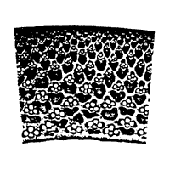
bamboo fibres

kinds of bamboo
|
The bamboo is in its size, lightness and strength an extreme product of nature. It is stable and because of its cavities an extreme light and elastic building material. The reinforcement by diaphragms and its physical conditions cause its enormous superiority compared to other building materials. |
|
guadua angustifolia
|
Throughout the world there are about 500 different species of bamboo sometimes within hundreds of subspecies. Even only in Colombia about 25 different giant bamboos are used for construction. To those belongs also the "guadia angustifolia" which we look at in this article. It grows in hights up to 1800 metres [NN], mostly in small forests along creeks but also on fields and inclinations. There exist two subspecies called guadua castilla andguadua mecana. It reaches a tallness of about 20-25 metres and a diameter up to 18 cm. |
|
bamboo root
|
Each stem grows out off a netkind rootsystem and reaches already after one year its total tallness. After that the [leitsysteme] start to lignify and in the next 6-8 years it gains harness and strength because of the silification of the outer tube wall. So bamboo can also be titled as a lignifying giant grass. |

coniferous wood fibres

bamboo fibres
|
The lignifying cell construction of the bamboo texture and its technical conditions are very similar to the original texture of wood. Whereas wood has got a hard centre [Hirnholz] and becomes weaker towardsthe outer parts [Splintholz], the bamboo is in its outer parts hard and in its inner parts weak, what causes a much more stable construction. From the inner parts of the tube towards the outer parts you can realize a continious accumulation of the[Leitbündel]. The more stable fibre structures are most dense where you find the strongest statical stress. |
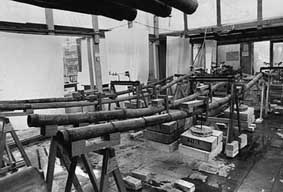
material testing
|
To evaluate and compare the material conditions of bamboo the descent, the age, the humidity content and of course the diameter of the tube are of emence importance. Comparing the different results of investigation of the strength properties of bamboo, so you can see that there is a big fluctuation of the results, although they all tested the same species of bamboo, the guadua angustifolia. | ||||||||||||||||||||||||||||||||||||||||||
Material parameters |
|||||||||||||||||||||||||||||||||||||||||||
|
Those information were given by the Stuttgarter Institut FMPA for the analysis of the Zeri-Pavillion. Unfortunately there are no information given about the specific material datas or conditions while testing the bamboo. You can find the article in the magazine "Bautechnik 77,2000 No 6/7". Merely they tell us that the tubes of guadua angustifolia should have had a diameter from 10 to 14 cm and a wall thickness from 15 to 20 mm. But the delivered tubes from Colombia differed much in size and quality and so it was necessary to test them, at least 3 per delivery. Accuratwe information about lenth and size are missing. | ||||||||||||||||||||||||||||||||||||||||||
comparison out off DB9/97 |
|||||||||||||||||||||||||||||||||||||||||||
| For the bending-, thrust- and tension-tests they investigated the
ultimate stress limit/breaking limit, which is not to mistake for the
permitted limiting stress. Dennoch ein Versuch. That chart comes from the DB, Deutsche Bauzeitung 9/97. |
||||||||||||||||||||||||||||||||||||||||||
Compressive Strength |
|||||||||||||||||||||||||||||||||||||||||||
| Compared to bigger tubes slim tubes have got in relation to their
cross section a higher compressive strength parallel and vertical to their
fibre. That relatively slimmer tubes possess better material conditions
is caused by the fact that bigger tubes have got a minor part of the outer
skin, which is very resistent in tension.
The unlimited longitudinal cleavability of the bamboo tube wall inside of
the internodium is caused by the strictly parallel directed fibres. Inside
thenodium they cross each other in each direction. This amplification
knots with its strongly silificated diaphragms increase the cleavability
strength and the buckling strength of the tubes. Even more we know that a
cylindrical tube compared to a solid round bar possesses a much higher
flexural strength.
The portion of lignin affects the compressive strength. Whereas the high portion of cellulose influences the buckling and the tension strength, because it represents the building substance of the bamboo fibre. |
||||||||||||||||||||||||||||||||||||||||||
Tensile strength |
|||||||||||||||||||||||||||||||||||||||||||
| Bamboo is able to resist more tensile than compression. Slim tubes are in this occasion superior, too. Inside the silificated outer skin you find axial-parallel extremly elastical fibres with a tensile strength up to 40kN/cm². As a comparison: extremly strong wood fibres can resist a tension up to 5 kN/cm² and steel St37 can resist as highest possible a tension of 37 kN/cm² (ultimate stress limit/breaking limit!) | ||||||||||||||||||||||||||||||||||||||||||
Elastical modulus |
|||||||||||||||||||||||||||||||||||||||||||
|
In connection with the elastic modulus you can see an
advantage in the use of slim tubes in relation to their cross section, too.
The accumulation of highly strong fibres in the outer parts of the tube
wall also work positive in connection with the elastical modulus like it
does for the tension shear and bending strength. There exist an perfect
relation of the cross section of the tube, if you fall below or above it
the elastical modulus decreases (the higher the elastical modulus of the
bamboo, the higher is the quality). Like the elastical modulus of solid
wood the one of bamboo also decreases 5 to10% with growing stress.
The enormous elasticity makes bamboo to be a very useful building material
in areas with high risk of earthquakes. In Asia they still construct
scaffolds with bamboo tubes.
|
||||||||||||||||||||||||||||||||||||||||||
|
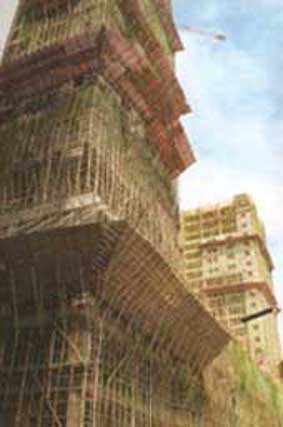
bamboo scaffold
|
||||||||||||||||||||||||||||||||||||||||||
| |||||||||||||||||||||||||||||||||||||||||||
Flexural (bending) strength |
|||||||||||||||||||||||||||||||||||||||||||
| Atrops analysed common bamboos: diameter of tubes= 70-100 mm, wallthickness= 6-12 mm with a span of 3,60m . The elastical deflections were minimum =1/25,9 und maximum 1/16,and as an average 1/20,1 of the spans. Where a deflection in the construction was unavoidable and annoying, one could bend the recently harvested tubes so that you get a superelevation, which later will be compensated under the working load. | ||||||||||||||||||||||||||||||||||||||||||
Shearing strength |
|||||||||||||||||||||||||||||||||||||||||||
| Especially for the construction of the bamboo tube joinings it is important to consider the shearing resistance. The influence of the distance of the shearing surfacedecreases with growing length of shearing surface. At a wall thickness of 10 mm the shearing strength is about 11% lower than at a tube with a wall thickness of 6 mm; this could be explained by the distribution of the high-strength fibres per cross section surface. The Values of the tables are from internodium material. The values for the nodien material are about 50 % higher. | ||||||||||||||||||||||||||||||||||||||||||
The fracture behaviour |
|||||||||||||||||||||||||||||||||||||||||||
|
The fracture behaviour The fracture behaviour |
The behaviour of breaking of common building wood differs clearly from the breaking conditions of bamboo. Here you don't have a spontanious break through the whole material after the tearing of single bamboo fibres like wood does. The appearing clefts are led off immediately in direction of the fibre and so they impair the critical region less. The energy transfer is delayed by diffusion. The distribution of the appearing longitudenal cracks all over the tube length are stopped by the enforcing knots (nodiens). Especially the pressure-, shearing-, and interlaminar strength are raised by the knots. Those symptoms are titled as increasing factor of the fracture toughness. In the research of modern compound material it is less important to prevent the formation of cracks than to counteract the distribution of the clefts by finding a suitable material construction. | ||||||||||||||||||||||||||||||||||||||||||
The fracture behaviour caused by a punch |
|||||||||||||||||||||||||||||||||||||||||||
|
The fracture behaviour |
The work that is needed for the punch of a bamboo tube is nearly the same whether the punch hits the knot or the internodium. But the breaking conditions itsself are totally different. If the punch hits the knot the tube will burst in axial stripes; that means a break as a result of the effort of the strength vertical to the fibres. If the punch hits the internodium you will find the actual break; that means break as a result of the effort of the tension strength in direction of the fibre. The results of the ultimate breaking punch (D=30 mm; d=4 mm) are about 2,65 mkp/cm². It is not comparable to the value of the spruce (0,5 mkp/cm²) because the bamboo is of course not solid but a tube. | ||||||||||||||||||||||||||||||||||||||||||
Examinations of the load-carrying capicity of the bamboo guadua angustifolia by Dr .Simon Eicher, Otto- Graf-Institut |
|||||||||||||||||||||||||||||||||||||||||||
| Examinations of the load-carrying capicity of the bamboo guadua angustifolia by Dr .Simon Eicher, Otto- Graf-Institut The assumptions were that the tubes had a slimness of diameter of 3<~r/t~<5,5, that they were placed in a non-climatical hall and that they had a moisture of about 15%. Some results: | ||||||||||||||||||||||||||||||||||||||||||
Testing of load limit of guadua angustifolia at the University of Valle, Cali with CIBAM in Palmira, Colombia |
|||||||||||||||||||||||||||||||||||||||||||
| Testing of load limit of guadua angustifolia at the University of Valle, Cali with CIBAM in Palmira, Kolumbien conducted under the direction of the architect Oskar Hidalgo Lopez, (Universidad National Bogota) and Ing. Jose Villar and Ing. Patricia Imery. The proceeding was orientated at the essay of Motoi Otta: 'Studies on the properties of Bamboo Stem'. | ||||||||||||||||||||||||||||||||||||||||||
|
§ 13 bamboos in the range between 9 and 13 cm of diameter and a length
of 17 to 23 m. § grown on about1000 m NN (against all expectations and former researches the relatively pressure strength increased insificantly with the hight bove ground) § the average diameter of the tube wall was at the bottom of the stem 22mm and at half of the hight about 10mm § the age was between 9 month and 7 years (explains essentially the big differences of the results). The pressure strength increased with the age. One year old tubes resisted a pressure of 2,61 kN/cm² and sixth year old tubes resisted a pressure of up to 7,05 kN/cm². But in spite of all expectations a one year old resisted a tension of 32,06 kN/cm² and the tension strength decreased at the 5 to six year olds distinctively. § Samples out off 4 fixed stem hights (dark outer zone with tight fibres of about 30% with a tension strength of 20,52 kN/cm² and a white inner zone of about 70% with a tension strength of only 7,06 kN/cm²; in the area of the knots (nodiens) the fibres are all different and you get an average result of about 11,75 kN/cm²) § Modifications of the dimension throughout the moistening above the fibre-saturation point, for example by the contact of fresh cement, relate especially soft young fibres to immense sonsume of water. Whereas older bamboo varies much less. |
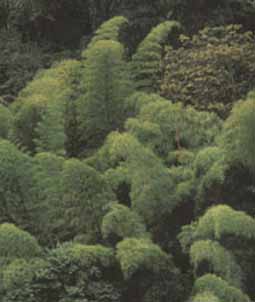
bamboo forest
|
It is easy to recognize that the research-results vary a lot. It is in question wether it is possible to compare them to each other. Especally because of the obscurity of the examination requirements. It has to be mentioned that every result is topped by the colombian examination results, CIBAM in co-operation with the Universidad del Valle, Cali (1000 m above NN) worked out a elastical modulor of 2.130 kN/cm² , other examinations in Medellin (1800 m) and in the coffee region 1400-1700 m NN present even higher values. Also the examinations about pressure and tension strength differ a lot. Some examinations distinguished wethter they tested tube parts with or without nodiens or they distinguished the thickness of the tubes. Besides the hight above NN the age of the tubes has got a big influence on the silification of the fibres and leads to an enormous increase of the pressure strength. | |||||||||||||||||||||||||
comparison of the examination results |
||||||||||||||||||||||||||
| ||||||||||||||||||||||||||
| To get an impression how different the results are and to make a decision wether they are comparable or not, here again a table with the most important results of the different institutes and examinations. | ||||||||||||||||||||||||||
Approximate recommended values of 'guadua angustifolia' |
||||||||||||||||||||||||||
| Although if you want to give approximate recommended values, you should take the lower results to stay on a safe level. Even then the bamboo still guarantees a perfect utilization of that unusual building material. |